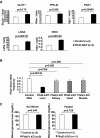Inhibition of the oxygen sensor PHD2 in the liver improves survival in lactic acidosis by activating the Cori cycle
- PMID: 26324945
- PMCID: PMC4577207
- DOI: 10.1073/pnas.1515872112
Inhibition of the oxygen sensor PHD2 in the liver improves survival in lactic acidosis by activating the Cori cycle
Abstract
Loss of prolyl hydroxylase 2 (PHD2) activates the hypoxia-inducible factor-dependent hypoxic response, including anaerobic glycolysis, which causes large amounts of lactate to be released from cells into the circulation. We found that Phd2-null mouse embryonic fibroblasts (MEFs) produced more lactate than wild-type MEFs, as expected, whereas systemic inactivation of PHD2 in mice did not cause hyperlacticacidemia. This unexpected observation led us to hypothesize that the hypoxic response activated in the liver enhances the Cori cycle, a lactate-glucose carbon recycling system between muscle and liver, and thereby decreases circulating lactate. Consistent with this hypothesis, blood lactate levels measured after a treadmill or lactate tolerance test were significantly lower in Phd2-liver-specific knockout (Phd2-LKO) mice than in control mice. An in vivo (13)C-labeled lactate incorporation assay revealed that the livers of Phd2-LKO mice produce significantly more glucose derived from (13)C-labeled lactate than control mice, suggesting that blockade of PHD2 in the liver ameliorates lactic acidosis by activating gluconeogenesis from lactate. Phd2-LKO mice were resistant to lactic acidosis induced by injection of a lethal dose of lactate, displaying a significant elongation of survival. Moreover, oral administration of a PHD inhibitor improved survival in an endotoxin shock mice model. These data suggest that PHD2 is a potentially novel drug target for the treatment of lactic acidosis, which is a serious and often fatal complication observed in some critically ill patients.
Keywords: PHD inhibitor; gluconeogenesis; hyperlactatemia; hypoxic response; sepsis.
Conflict of interest statement
The authors declare no conflict of interest.
Figures








Similar articles
-
Targeting Oxygen-Sensing Prolyl Hydroxylase for Metformin-Associated Lactic Acidosis Treatment.Mol Cell Biol. 2017 Jul 28;37(16):e00248-17. doi: 10.1128/MCB.00248-17. Print 2017 Aug 15. Mol Cell Biol. 2017. PMID: 28606929 Free PMC article.
-
Hepatic PHD2/HIF-1α axis is involved in postexercise systemic energy homeostasis.FASEB J. 2018 Sep;32(9):4670-4680. doi: 10.1096/fj.201701139R. Epub 2018 Mar 30. FASEB J. 2018. PMID: 29601782
-
Conditional knockout of prolyl hydroxylase domain protein 2 attenuates high fat-diet-induced cardiac dysfunction in mice.PLoS One. 2014 Dec 29;9(12):e115974. doi: 10.1371/journal.pone.0115974. eCollection 2014. PLoS One. 2014. PMID: 25546437 Free PMC article.
-
Lactic Acidosis in Sepsis: It's Not All Anaerobic: Implications for Diagnosis and Management.Chest. 2016 Jan;149(1):252-61. doi: 10.1378/chest.15-1703. Epub 2016 Jan 6. Chest. 2016. PMID: 26378980 Review.
-
Lactic acidosis.Minerva Anestesiol. 2003 Apr;69(4):281-4. Minerva Anestesiol. 2003. PMID: 12766720 Review.
Cited by
-
GC-MS analysis of 4-hydroxyproline: elevated proline hydroxylation in metformin-associated lactic acidosis and metformin-treated Becker muscular dystrophy patients.Amino Acids. 2024 Mar 10;56(1):21. doi: 10.1007/s00726-024-03383-9. Amino Acids. 2024. PMID: 38461423 Free PMC article.
-
The Hormetic Adaptative Capacity and Resilience to Oxidative Stress Is Strengthened by Exposome Enrichment with Air Cold Atmospheric Plasma: A Metabolome Targeted Follow-Up Approach.Biomedicines. 2025 Apr 12;13(4):949. doi: 10.3390/biomedicines13040949. Biomedicines. 2025. PMID: 40299663 Free PMC article.
-
Risk Factors for Postoperative Mortality in Patients with Colorectal Diverticular Perforation.J Anus Rectum Colon. 2024 Oct 25;8(4):279-288. doi: 10.23922/jarc.2024-021. eCollection 2024. J Anus Rectum Colon. 2024. PMID: 39473706 Free PMC article.
-
Targeting hypoxia-inducible factors: therapeutic opportunities and challenges.Nat Rev Drug Discov. 2024 Mar;23(3):175-200. doi: 10.1038/s41573-023-00848-6. Epub 2023 Dec 20. Nat Rev Drug Discov. 2024. PMID: 38123660 Free PMC article. Review.
-
Changes in expression of genes related to glucose metabolism in liver and skeletal muscle of rats exposed to acute hypoxia.Heliyon. 2020 Jul 2;6(7):e04334. doi: 10.1016/j.heliyon.2020.e04334. eCollection 2020 Jul. Heliyon. 2020. PMID: 32642586 Free PMC article.
References
-
- Kaelin WG, Jr, Ratcliffe PJ. Oxygen sensing by metazoans: The central role of the HIF hydroxylase pathway. Mol Cell. 2008;30(4):393–402. - PubMed
-
- Semenza GL. Oxygen sensing, homeostasis, and disease. N Engl J Med. 2011;365(6):537–547. - PubMed
-
- Epstein AC, et al. C. elegans EGL-9 and mammalian homologs define a family of dioxygenases that regulate HIF by prolyl hydroxylation. Cell. 2001;107(1):43–54. - PubMed
Publication types
MeSH terms
Substances
Grants and funding
LinkOut - more resources
Full Text Sources
Other Literature Sources
Molecular Biology Databases

